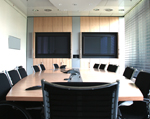It’s January, and that means new budgets for companies that operate on the calendar year. If this year is anything like the last, it means we will be receiving calls from companies inquiring about corporate board room video conferencing systems. As AV Consultants, one of the most common questions we get asked is, “What do other companies have for AV equipment in their Boardrooms?” And the follow up question is always, “Should we be looking at a video conferencing solution?” It seems, in the business world, everyone is concerned that if their technology is behind the curve, then they won’t be as competitive. And we are all concerned about how these new technologies affect our bottom line. But believe it or not, video conferencing may be a viable and cost-saving solution for almost any company that seeks to enhance its communications.
As most of our readers know, we do not sell video conferencing equipment, and we don’t represent any products or manufacturers. As an independent consulting firm, our clients come to us for unbiased recommendations on AVL systems design and implementation. In other words, we can help you figure out what you need, how to integrate it, and how to use it, but we don’t sell the equipment itself (this is how our recommendations stay objective).
Back to video conferencing. In the current economic times, companies are aggressively looking for ways to cut costs. Sending people to meetings (whether across the state or across the country) is a huge expense for many organizations. Some companies are happy to set up a small webcam with an internet connection for an “instant” videoconference. This works fine if lower quality is acceptable for your needs. However, many companies come to us for advice after they’ve tried that option and found it to be an abysmal failure.
The webcam conference model generally fails in the business world because it presents a host of communication problems (poor image quality, poor audio quality, unreliable connection speeds, and user error, just to name a few) and all of this adds up to make for a poor video conferencing experience. After a while, clients and coworkers tend to prefer driving long distances and coming to meetings in person, rather than putting up with the headaches that webcams present. As a rule, companies will stomach the overhead costs of mileage and time on the road if the video conferencing system (or webcam system) is unreliable and unprofessional.
When we design audio-visual systems for corporate board rooms and conference rooms, there are 4 basics principals that have to be followed consistently for individuals to report a satisfactory video conferencing experience:
- Users have to be able to intuitively turn the system on and connect.
- Lighting in the room must be designed to specifically support video conferencing.
- Wall finishes and treatments must provide good sound absorption, minimal patterns, and proper colors to optimize bandwidth.
- Mechanical Systems and background noise must be very low.
These principles, combined with the right AVL equipment, can create an exceptional video conferencing experience. When designed right, it can dramatically reduce time and travel costs for important business meetings. If you’re looking to utilize technology to help reduce costs and impact your bottom line, contact us to learn how a video conferencing system may just fit into this year’s budget.
